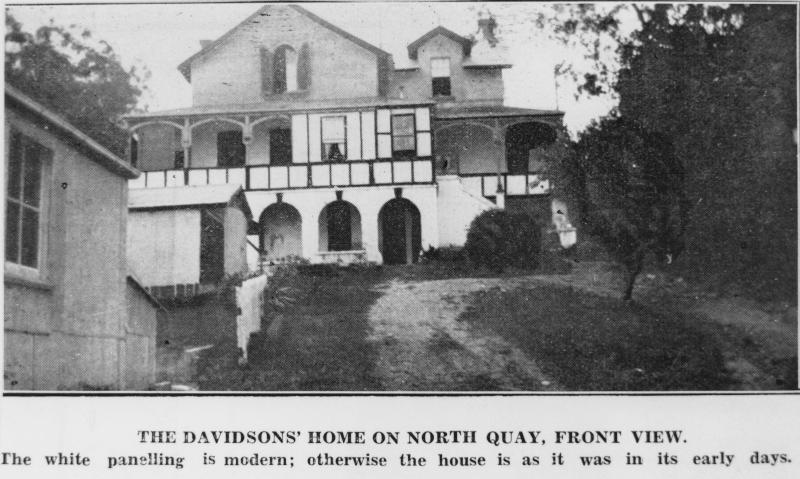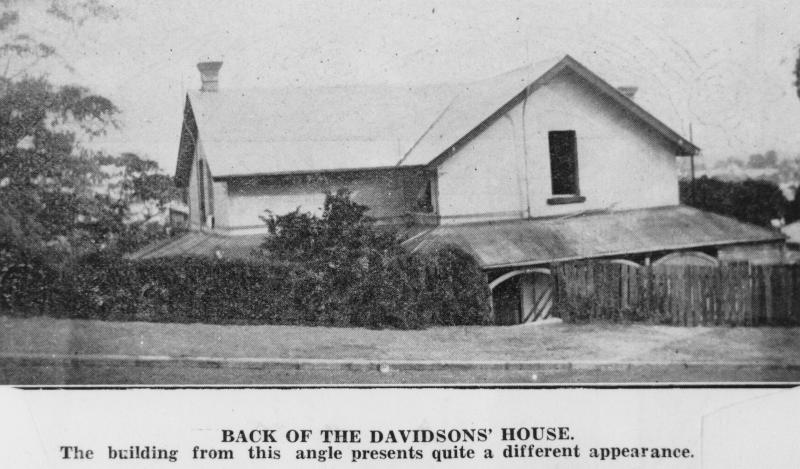Addresses
Type of place
House
Period
Victorian 1860-1890
Style
Free Gothic
Addresses
Type of place
House
Period
Victorian 1860-1890
Style
Free Gothic
This residence was built c.1868 as the grand home of successful retailer Robert Davidson. The property ran downhill to the Brisbane River and previously had the address of 413 River Terrace (now Coronation Drive). In 1922, the house was converted into rental accommodation. It was named ‘Bunya Flats’ in 1937. In 1998, the run-down, inner city flats were transformed into a modern backpackers hostel. Built at a time when shops and homes shared City streets, it is a rare 1860s building and the last nineteenth century grand residence remaining within the boundaries of the CBD.
Also known as
Yellow Submarine Backpackers Hostel
Lot plan
L16_RP8698; L15_RP73210
Key dates
Local Heritage Place Since —
Date of Citation —
Construction
Roof: Corrugated iron;Walls: Masonry
Criterion for listing
(A) Historical; (B) Rarity; (C) ScientificInteractive mapping
Also known as
Yellow Submarine Backpackers Hostel
Lot plan
L16_RP8698; L15_RP73210
Key dates
Local Heritage Place Since —
Date of Citation —
Construction
Roof: Corrugated iron;Walls: Masonry
Criterion for listing
(A) Historical; (B) Rarity; (C) ScientificInteractive mapping
History
This property was first offered for freehold sale ten years after the closure of the Moreton Bay Penal Settlement. On 1 March 1852, James Gibbon purchased 1 acre, 1 rood and 24 perches of hilly, vacant land, running down to the Brisbane River and within walking distance of Brisbane Town. He paid £11 and 18 shillings for Allotment 4. He subdivided the large block into smaller allotments for sale in 1865.
On 12 October 1866, Robert Davidson of Brisbane acquired subdivisions 15, 16 and 31 of Section 2 of Lot 4. He had acquired 1 rood and 2.6 perches of undeveloped land that ran downhill to North Quay, the road that ran along the banks of the Brisbane River. Subdivision 31 connected to North Quay. Subdivisions 15 and 16 formed the rear of his property and these blocks were accessed via an, as yet, unnamed road (i.e. Quay Street). Davidson was a successful auctioneer with offices in George Street, Brisbane Town. His obvious success “is evidenced by the fine old home that he was able to erect on North Quay”.1
Robert Davidson had his home built at the top of his sloping block with the front of the house facing the Brisbane River so providing spectacular views of the river’s Milton Reach plus the South Brisbane peninsular. To allow easy access for supplies to be delivered to his property from nearby Brisbane Town, the rear of the house was located close to Quay Street. This allowed easier access to Davidson’s residence than the front of the block that sloped steeply down towards the Brisbane River. It was a large, three storey house built into the hillside and surrounded on all four aspects by verandahs. Built of brick and plaster-faced, Davidson’s gabled house featured pillared arches supporting the front verandah. It had three chimneys servicing multiple fireplaces that were spread across each level. The grounds at the front of the house featured gardens, a well and a tennis court.
The Davidson home was completed by 1868. Robert Davidson first appears in the 1876 Edition of the Queensland Post Office Directories. He is listed as a resident of Milton, which, at that time, may have encompassed Quay Street. The residence is shown in a pencil and watercolour sketch drawn by artist Henry Grant Lloyd (1830-1904) that is dated 6 May 1873. The painting is in the collection of the Mitchell Library, Sydney. In the 1878 Edition of the Queensland Post Office Directories, he is listed as living in Quay Street. In the 1885-86 Edition, the address had changed from Quay Street to North Quay. This reflected that the house had its main carriageway entrance located at the front of the house overlooking the river.
Robert Davidson died on 30 April 1885 on a family holiday to Britain. His property was transmitted to trustees Robert Richards (R.R.) Davidson, John Lockhart Sloane and John Potts. Sloane was Robert Davidson’s son-in-law. Robert’s widow continued to reside in the family home even after the estate was settled and property transferred to R.R. Davidson and John Lockhart Sloane on 18 June 1891. During 1893-95, the property retained two separate postal addresses. Widow Davidson still resided at her North Quay address but a Miss Davidson lived at the back of the house and had a Quay Street postal address. R.R. Davidson died 14 January 1899 and the property passed again to Sloane but also to the widow Sophia Eliza Davidson and John George Cribb. Cribb died on 10 June 1905 causing another change of ownership. Sloane remained a joint owner along with Sophia E. Davidson and spinster Jane Davidson plus Benjamin Cribb. Sophia E. Davidson died on 12 March 1915. Miss S. Davidson lived at their North Quay home until 1922 when the Davidson family ended their more than 50-year association with this site. On 29 September 1922, title transferred to Herbert Brealy Hemming. This transfer of ownership was linked to a £1,000 mortgage taken out by spinster Jane Vercoe Davidson and Benjamin Foote Cribb on the same day. Hemming provided the loan to Davidson and Cribb. On 5 June 1923, Cribb’s share of the mortgage was transferred Henry Clement Davidson.
The Davidson’s Residence had been allotted the street number 413 in North Quay by 1902. It acquired a new (third) postal address of 413 River Road (later renamed Coronation Drive) in 1926. By 1923, Hemming had converted the large residence into rental accommodation housing three or four residents. Hemming leased the front grounds, allowing the erection of some cottages and the Eastern Planters Packing Company building. Conversion of old, nineteenth century houses into inner-city flats was a common practice in Brisbane during the interwar period. It was cheaper and faster than building new, modern apartments and allowed a maximum return on a rental property, while at the same time meeting the increasing demand for accommodation by City workers. Job opportunities such as at the Morrows, later Arnott’s Biscuit factory (established 1900) in nearby Boomerang Street plus the close proximity of the CBD, the Roma Street tramline and Roma Street Station made the conversion of the Davidson Residence into flats a sound investment. In 1937, the former Davidson’s Residence was renamed ‘Bunya Flats’.
When Hemming died on 8 March 1942, the property became the responsibility of the state government’s Queensland Trustees Limited. During World War II, state legislation required the construction of an air raid shelter for the tenants. The post-war period saw the gradual reduction in size of Davidson’s original purchase. Resubdivision 2 (1.9 perches) was sold in 1951, followed by another 11.3 perches in 1953. By October 1953, John H. and Roland M. Propsting had joint ownership of the flats and the remaining 1 rood and 4.3 perches of land. In 1954, the property went to family members William, Gordon W. and Douglas D. McNicol, who further subdivided it. On 30 August 1955, 28.5 perch were sold to Lillian Ivy May Tidey, severing the former Davidson’s residence from its riverfront grounds. ‘Bunya Flats’ had ceased being listed as a Coronation Drive address by 1940. Subsequently, its main entrance was relocated to Quay Street, as it had been from 1868 to 1886. The property’s Coronation Drive frontage became the site of the Queensland Tyre Service. The air raid shelter was converted into an office.
In 1969, Louis D. Bickle acquired the flats. In 1978, the Merivale Rail Bridge’s construction saw the closure of the Quay Street section adjoining the property plus the demise of nearby River Street. The subsequent road realignment caused ‘Bunya Flats’ to be positioned on Quay Street’s new corner, directly across from the busy Roma Street to South Brisbane stations rail link. By 1989, over 65 years of usage as inner-city flats had led to the former Davidson’s Residence’s deterioration. The Sunday Mail described it as a “run-down, three-story block of flats” that had “provided cheap accommodation for elderly pensioners and loners”.1 The old house contained 19 rented rooms plus a caretaker’s flat. Both the National Trust (Qld) and the Brisbane History Group had identified 66 Quay Street as having heritage significance. The old flats were for sale for $320,000 with real estate agents advertising their restoration or demolition. The newspaper warned that the property “may soon join the ranks of Brisbane’s lost heritage, if a suitable buyer cannot be found.”1
The flats remained in Bickle family hands until 1995, when Denbrook Investments Pty Ltd purchased it. In June 1998, an application was made to the Brisbane City Council to convert the old flats into a backpackers’ hostel to meet the need of Brisbane’s burgeoning youth tourism market. Renamed the Yellow Submarine Backpackers in the City hostel, the building underwent major renovation and modernisation including the addition of a pool, the creation of a TV, Video and Stereo Lounge plus Internet connections. The history of the site was incorporated into the hostel’s marketing. A 2004 brochure for the Yellow Submarine Backpackers emphasised “Our historic colonial home has a heritage born of nearly one hundred years service to guest and travellers” and “Great atmosphere in a grand historic home’. The original fireplaces are advertised as a hostel attraction.
Davidson’s Residence (former) is a reminder of the early development of what is now Brisbane’s Central Business District. Both homes and shops lined the streets of Brisbane Town during the nineteenth century. By the 1920s, most of these residences were demolished to make way for the commercial buildings that came to define the CBD. The former Davidson’s Residence is the only large, nineteenth century residence surviving within the boundaries of the CBD. The building at 66 Quay Street has had continuous usage as private accommodation in the CBD for more than 140 years. As well, 66 Quay Street is the oldest residence in the only surviving residential precinct in the CBD, based upon 8 houses or hostels scattered along Upper Roma and Quay Streets. It is rare as one of the few 1860s buildings to be found across Brisbane.
Statement of significance
Relevant assessment criteria
This is a place of local heritage significance and meets one or more of the local heritage criteria under the Heritage planning scheme policy of the Brisbane City Plan 2014. It is significant because:
Supporting images

The Queenslander (Brisbane, Qld. : 1866-1939),
‘Front view of The Davidson's home on North Quay, Brisbane, 1931',
John Oxley Library, State Library of Queensland

The Queenslander (Brisbane, Qld. : 1866-1939),
‘Rear of Davidson's house, originally constructed in the 1860s by Robert Davidson, North Quay, Brisbane, 1931',
John Oxley Library, State Library of Queensland
Photograph caption: Back of the Davidsons' House. The building from this angle presents quite a different appearance.
Residence, once facing North Quay, originally constructed in the 1860s by Robert Davidson. In 1931 known as Bunya Flats. (Description supplied with photograph)
References
-
Lord, F.E., “Brisbane’s Historic Homes, No.LX, The Old Home of the Davidsons on North Quay, The Queenslander, 30 April 1931, p.46.
-
"Historic home faces destruction”. The Sunday Mail, 23 April 1989, p.?
-
Ibid
-
Brisbane City Council, 1946, 2001 & 2009 aerial photographs
-
Brisbane City Council, Properties on the Web, website
-
Brisbane City Council, post-1946 Building Cards
-
Brisbane City Council, Sewerage Plan No.24, 19 February 1926
-
Department of Natural Resources, Queensland. Certificates of Title and other records
-
Henry Grant Lloyd, pencil and watercolour sketch of the Davidson House, 6 May 1873, (Mitchell Library Collection, Sydney)
-
John Oxley Library, photographic collection.
-
Queensland Post Office Directories, 1868-1949 editions
-
Lord, F.E., “Brisbane’s Historic Homes, No.LX, The Old Home of the Davidsons on North Quay, The Queenslander, 30 April 1931
-
National Trust of Queensland, ‘Davidson House’ file
-
"Historic home faces destruction”. The Sunday Mail, 23 April 1989
-
Yellow Submarine Backpackers, 6-page colour advertising brochure, 2004
Citation prepared by — Brisbane City Council (page revised June 2022)